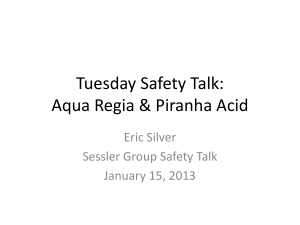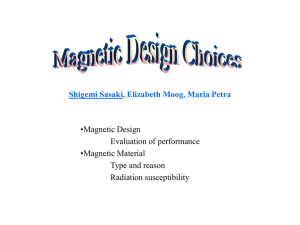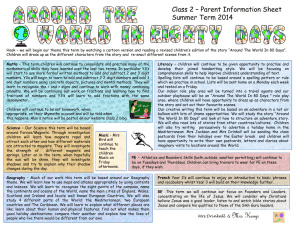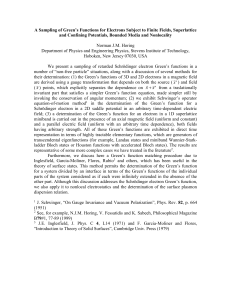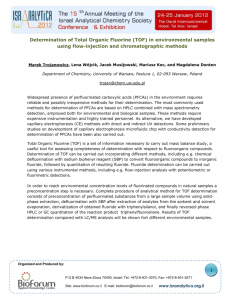Journal of Material Cycles and Waste Management
advertisement
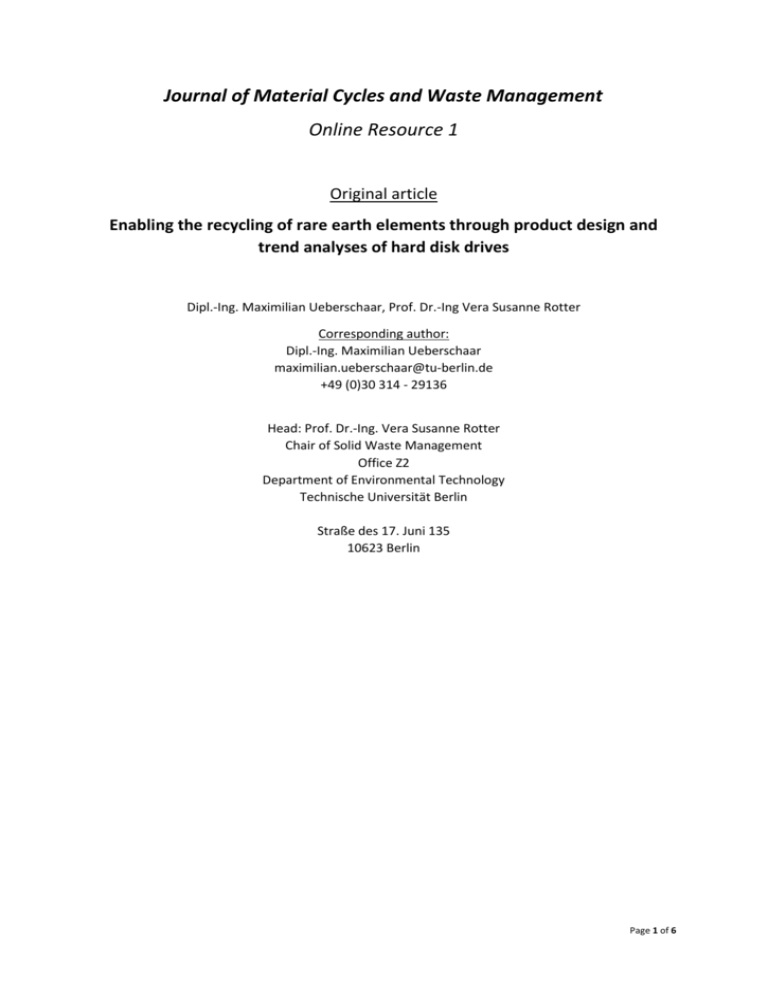
Journal of Material Cycles and Waste Management Online Resource 1 Original article Enabling the recycling of rare earth elements through product design and trend analyses of hard disk drives Dipl.-Ing. Maximilian Ueberschaar, Prof. Dr.-Ing Vera Susanne Rotter Corresponding author: Dipl.-Ing. Maximilian Ueberschaar maximilian.ueberschaar@tu-berlin.de +49 (0)30 314 - 29136 Head: Prof. Dr.-Ing. Vera Susanne Rotter Chair of Solid Waste Management Office Z2 Department of Environmental Technology Technische Universität Berlin Straße des 17. Juni 135 10623 Berlin Page 1 of 6 1. Optimizing laboratory work for determination of REE in NdFeB magnets In the following, approaches with X-Ray fluorescence and ICP-OES for optimizing the determination of REE in NdFeB magnets are described. Wet-chemical analysis Developing standard methodologies for the determination of REE in NdFeB magnets various approaches for the preparation of the samples and conducting the leaching processes were used to obtain comparable results. Each approach was carried out with industrial NdFeB rod magnets (3mm x 6mm) with no or only small differences in their chemical compositions. Beside the chemical composition itself the coating Ni-Cu-Ni is comparable to the material used for NdFeB magnets in hard disk drives. Analogue to possible preparation steps the samples were milled (<0,2mm), roughly crushed, heated and crushed, cut and processed as complete magnet. Following standard leaching procedures for dissolving metallic samples were chosen: HCL (hydrochloric acid), HNO3 (nitric acid), HNO3-H2O2 (10 nitric acid – 1 hydrogen peroxide), HNO3-H2O (1 nitric acid – 2 water) and HNO3-3HCL (aqua regia) (cf.Fig 1) [1]. Sample preparation Complete • HCL • HNO3 • HNO3-H2O2 • HNO3-H2O • Aqua regia Milled • HCL • HNO3 • HNO3-H2O2 • HNO3-H2O • Aqua regia Roughly crushed • HCL • HNO3 • HNO3-H2O2 • HNO3-H2O • Aqua regia Heated • HCL • HNO3 • HNO3-H2O2 • HNO3-H2O • Aqua regia Cut • HCL • HNO3 • HNO3-H2O2 • HNO3-H2O • Aqua regia Dissolving Fig 1 Applied sample preparation approaches Except for HNO3-H2O, for all preparations a microwave-assisted digestion was used (1200W, 20bar, 200°C, 15:00min). For HNO3-H2O, two approaches were tested; digestion at room temperature and microwave-assisted digestion (400W, 20bar, 200°C, 15:00min). For the determination of the chemical composition an ICP-OES was used (Thermo Scientific iCAP 6000 Series). All approaches were executed with a 3-fold determination. Following elements were determined: Silver (Ag), Aluminum (Al), Arsenic (As), Gold (Au), Boron (B), Cerium (Ce), Cobalt (Co), Copper (Cu), Dysprosium (Dy), Europium (Eu), Iron (Fe), Germanium (Ge), Lanthanum (La), Neodymium (Nd), Nickel (Ni), Palladium (Pd), Praseodymium (Pr), Platinum (Pt), Antimony (Sb), Samarium (Sm), Tin (Sn), Tantalum (Ta), Terbium (Tb), Zinc (Zn). Focusing on detected REE, the results for Dy, Nd, Pr, Tb and also B, Fe and Ni were compared. Fig 2 shows results for Nd exemplary for a comparable decision making. For other REE see “2 Results of REE related to different sample preparation methods”. Page 2 of 6 300000 250000 Roughly crushed [mg/kg] 200000 complete 150000 milled 100000 heated 50000 cut I Standard deviation 0 HCL HNO3 HNO3-H2O2 HNO3-H2O Aqua regia Fig 2 Results of various approaches for determination of Nd in NdFeB magnets Evaluation of all results shows two possible approaches for the determination of the chemical composition of NdFeB magnets. For the sample preparation milling but also crushing is sufficient and HNO3-H2O and aqua regia can be applied for the microwave-assisted digestion step. Approaches with untreated magnets are not feasible as the coating prevents partially the magnets from dissolving. The tests showed conspicuous interdependences of particular elements. To avoid misinterpretation of analytical results cross-comparisons were carried out to evaluate influences of present elements on elements to be detected. These tests were made for the pairs Ag-Cu, Ce-Nd, Ga-Ce, Ga-Nd, Pt-Co, ZnCu and Zn-Ni in a 2-fold determination with the concentrations 10mg/l and 20mg/l for the investigated elements. Significant impacts were measured for Nd-Ce and Ag-Cu. Table 1 shows differences between inserted standards and the result for the chemical analyses. Table 1 Differences in cross-comparison for Ce-Nd and Ag-Cu False detection % Used standard Ce4040 Nd4012 130,4 129,7 0,0 0,6 0,5 1,5 4,3 4,6 Nd 10mg/l Nd 20mg/l Ce 10mg/l Ce 20mg/l False detection % Used standard Cu 10mg/l Cu 20mg/l Ag 10mg/l Ag 20mg/l Ag2246 Cu3247 -7,7 -19,7 -13,5 -2,5 3,1 -1,4 0,0 0,0 A solution with only added Neodymium shows in chemical analyses detected Cerium with a difference up to 130% to its real value related to the inserted standard. In contrast, present Cerium does not influence the values for the detection of Nd. The same observations apply for the detection of Copper and Gold. These issues lead to an exclusion of Ce and Ag for further determinations. X-Ray fluorescent analysis To obtain a second set of results for the chemical composition, X-Ray fluorescence technique (Panalytical PW 2400 x-ray spectrometer) for the analysis of NdFeB magnets was tested. Using XRF analyses for a quantitative determination of the chemical composition of WEEE have not been established yet. Since XRF technique is a comparative measuring method, physical standards with a comparable matrix are needed. For rare earth elements in WEEE no standards are available yet. Page 3 of 6 Therefore, settings with pre-installed standards which are not optimized for REE in WEEE have to be used. A reliable and quantitative determination is hereby not possible. Laboratory XRF analysis devices work with different sample preparation methods. Fused tablets and powder pressed tablets are used for best possible results. For the preparation of a powder pressed tablet 1,5g wax (Merck KGaA, Hoechst wax C micropowder) was mixed with 6g sample material. For materials with high differences in density a swirling procedure is used in which the milled sample material is mixed with the wax in air. Even this cannot ensure a homogeneous density of the material. This leads to different results for the same sample. First measuring tests showed that attributing obtained peaks to specific REE is not possible. Furthermore, through the optical properties of the surface accuracy decreases by 10-20%. Due to these issues, no further investigation with powder pressed tablets were made in this case study. Preparing fused tablets, 0,6g sample material is melted with 3,6g soldering flux (lithium tetraborate:lithium metaborate, 66%:34%; Fluxana, HD Elektronik) at over 1000°C in a platinum crucible. The use of platinum crucibles exclude the determination of platinum group metals, Gold and Silver in the subsequent analysis as these materials are part of the alloy. As the melting process must not exceed higher temperatures than externally applied, the sampling material must not contain sulfides, high metal and/or phosphor contents. Otherwise exothermal reactions may occur and the crucible will be destroyed. To avoid those reactions milled sample material was heated in a muffle furnace to over 1000°C to force oxidation processes. This procedure leads to a loss of material due to annealing loss of volatile substances and in contrast to an increase of the mass due to oxidation processes. Therefore, a quantitative determination of the containing elements is not possible any more. Subsequent analytical results cannot be used for comparison purposes. Carrying out the burning process in a protective atmosphere has not been tested. Both approaches for a sample preparation, fused tablets and fused tablets, are not suitable for a quantitative determination of REE in WEEE, e. g. NdFeB magnets in hard disk drives. But a qualitative measurement of the chemical composition is possible to adjust the wet-chemical analyses. 2. Results of REE related to different sample preparation methods 60000 50000 [mg/kg] 40000 Hammer 30000 complete 20000 milled 10000 0 heated cutted I Standard deviation Fig 3 Results of various approaches for determination of Pr in NdFeB magnets Page 4 of 6 1800 1600 1400 [mg/kg] 1200 1000 Hammer complete 800 600 400 milled heated cutted 200 0 I Standarddeviation Fig 4 Results of various approaches for determination of Dy in NdFeB magnets 30 25 [mg/kg] 20 15 Hammer complete milled 10 heated cutted 5 I Standarddeviation 0 Fig 5 Results of various approaches for determination of Tb in NdFeB magnets Page 5 of 6 3. References 1. Bock R (2005) Handbuch der analytisch-chemischen Aufschlussmethoden. Wiley-VCH Verlag GmbH & Co. KGaA, Weinheim Page 6 of 6
